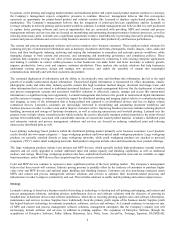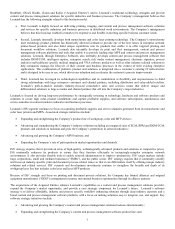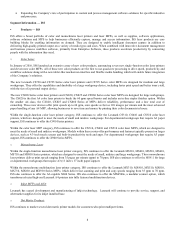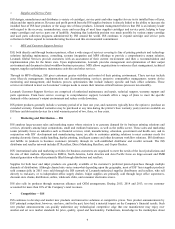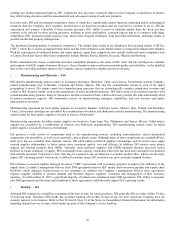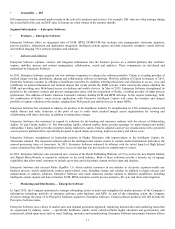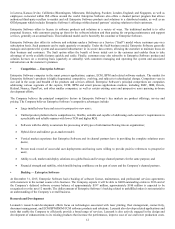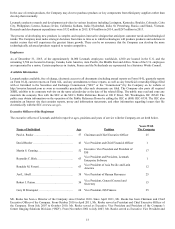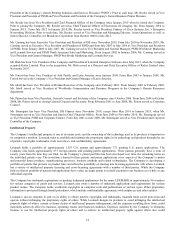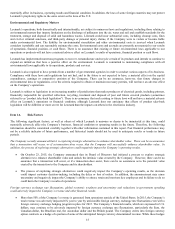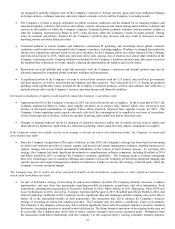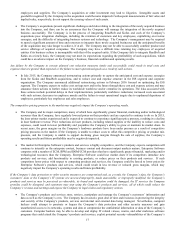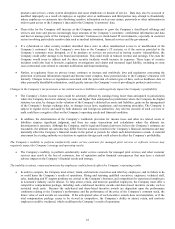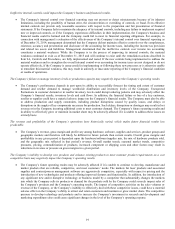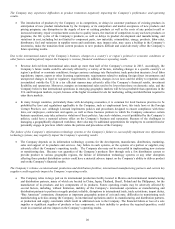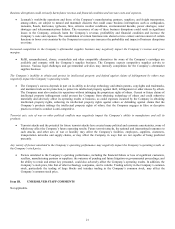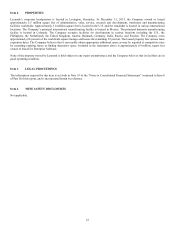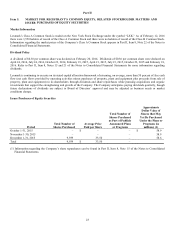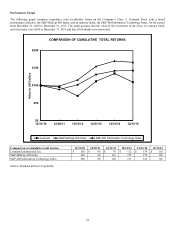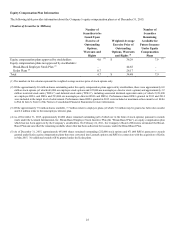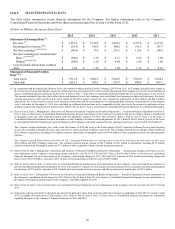Lexmark 2015 Annual Report Download - page 20
Download and view the complete annual report
Please find page 20 of the 2015 Lexmark annual report below. You can navigate through the pages in the report by either clicking on the pages listed below, or by using the keyword search tool below to find specific information within the annual report.16
are designed to partially mitigate some of the Company’s exposure to foreign currency gains and losses, additional changes
in foreign currency exchange rates may adversely impact economic activity and the Company’s operating results.
The Company’s revenue is largely dependent on global economic conditions and the demand for its imaging products and
associated supplies, solutions and services and capture, content, and process and output management software solutions and
services in the markets in which the Company competes. Continued global economic weakness and uncertainty, similar to
what the Company experienced in Brazil in 2015, could adversely affect the Company’s results in future periods. During
times of economic uncertainty, demand for the Company’s products may decrease and may result in decreased revenue,
operating income and other financial results.
Continued softness in certain markets and industries, constrained IT spending, and uncertainty about global economic
conditions could result in lower demand for the Company’s products, including supplies. Weakness in demand has resulted in
intense price competition and may result in excessive inventory for the Company and/or its reseller channel, as the Company
experienced in Europe in 2015, which may adversely affect sales, pricing, risk of obsolescence and/or other elements of the
Company’s operating results. Ongoing weakness in demand for the Company’s hardware products may also cause erosion of
the installed base of products over time, thereby reducing the opportunities for supplies sales in the future.
Restrictions on credit globally and credit risk associated with the Company’s customers and channel partners may also be
adversely impacted by continued global economic weakness and uncertainty.
A significant portion of the Company’s revenue is derived from contracts with the U.S federal, state and local governments
and their agencies, as well as international governments and their agencies. Any reductions in U.S. or foreign government
spending could significantly reduce demand for the Company’s hardware products, services and solutions and could have a
material adverse effect on the Company’s revenue, operating income and financial condition.
Decreased consumption of supplies could negatively impact the Company’s operating results.
Approximately 60% of the Company’s revenue in 2015 was derived from the sale of supplies. In the second half of 2015, the
Company announced efforts to reduce laser supplies inventory in its partner sales channel which were elevated in part
because of decreased consumption of supplies. These efforts adversely impacted laser supplies revenue for 2015. The
Company’s future operating results may be adversely affected if the consumption of its supplies by end users of its products
is lower than expected or declines, if there are declines in pricing, unfavorable mix and/or increased costs.
Changes of printing behavior driven by adoption of electronic processes and/or use of mobile devices such as tablets and
smart phones by businesses could result in a reduction in printing, which could adversely impact consumption of supplies.
If the Company cannot successfully execute on its strategy to become an end-to-end solutions provider, the Company’s revenue and
gross margin may suffer.
Since the Company’s acquisition of Perceptive Software in June 2010, the Company’s strategy has been based on becoming
an end-to-end solutions provider of content, capture, and process and output management solutions, enabling businesses to
capture, manage and access critical unstructured information in the context of their business process. In executing that
strategy, the Company has made significant investments in complementary software companies, including ReadSoft in 2014
and Kofax Limited in 2015, to enhance the Company’s solutions capabilities. The Company needs to continue integrating
these new technologies into its solutions offerings and continue to focus the Company on delivering integrated imaging and
content, process and output management solutions to businesses. Failure to execute this strategy could adversely affect the
Company’s revenue and gross margin.
The Company may fail to realize all of the anticipated benefits of any investments, acquisitions or other significant transactions,
which could harm financial results.
As part of Lexmark’s strategy of becoming an end-to-end solutions provider, the Company routinely discusses, evaluates
opportunities, and may enter into agreements regarding possible investments, acquisitions, and other transactions. Such
transactions, including the acquisitions of Perceptive Software in 2010; Pallas Athena in 2011; Brainware, Nolij, ISYS and
Acuo Technologies in 2012; AccessVia, Twistage, Saperion and Pacsgear in 2013; ReadSoft and GNAX Health in 2014, and
Claron Technology and Kofax in 2015 routinely involve significant risks and challenges and the Company may not be able to
realize all of the anticipated benefits of such transactions. The transaction may fail to advance the Company’s business
strategy of becoming an end-to-end solutions provider. The Company may not realize a satisfactory return on investment.
The Company’s due diligence process may fail to identify significant issues with an acquired company’s products, financial
disclosures, accounting practices or internal control deficiencies. The future business operations of an acquired entity may not
be successful. The Company may not be able to realize expense synergies and revenue expansion goals. Disruptions from
the transaction could harm relationships with the Company’s or the acquired entity’s existing customers, business partners,


